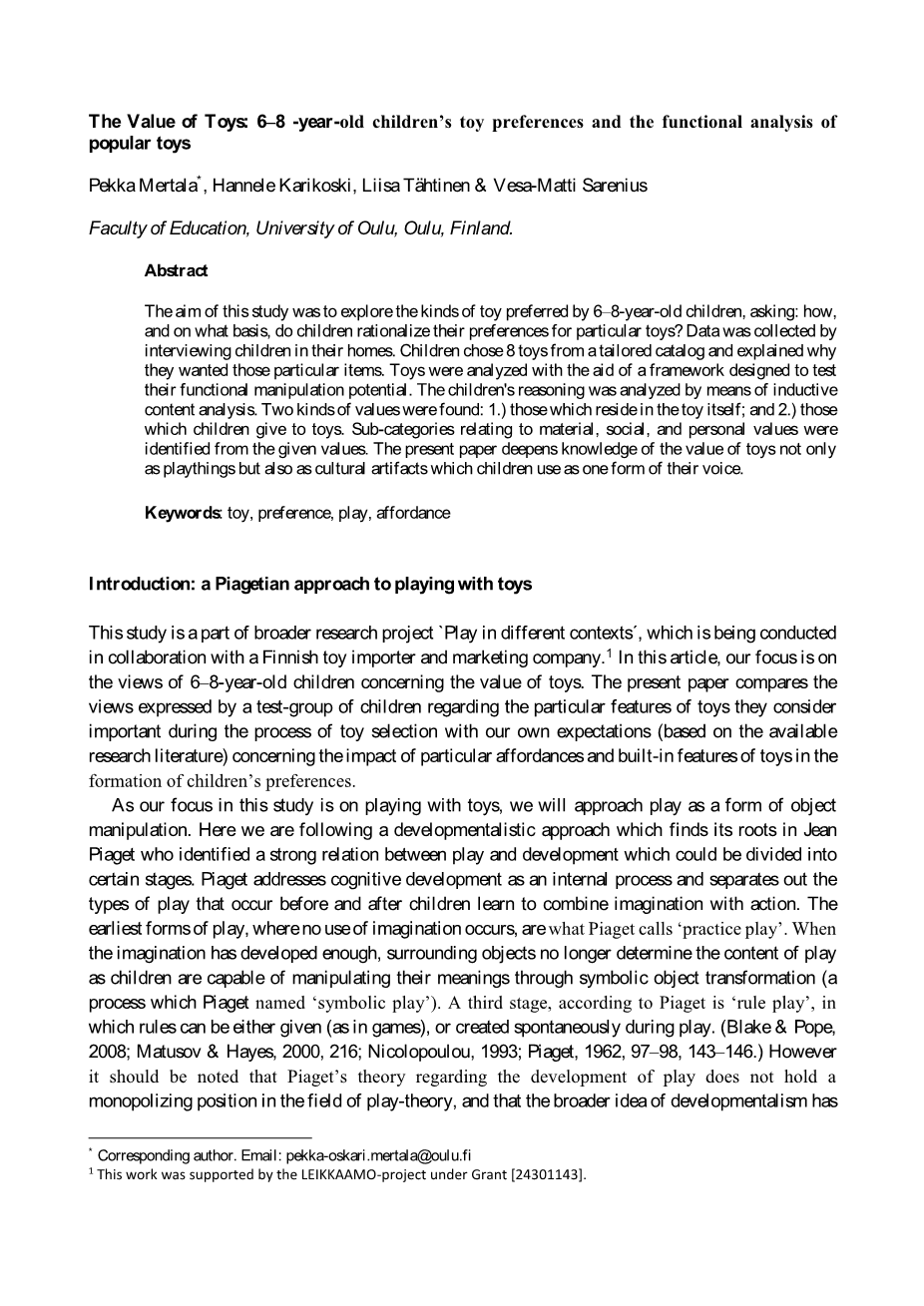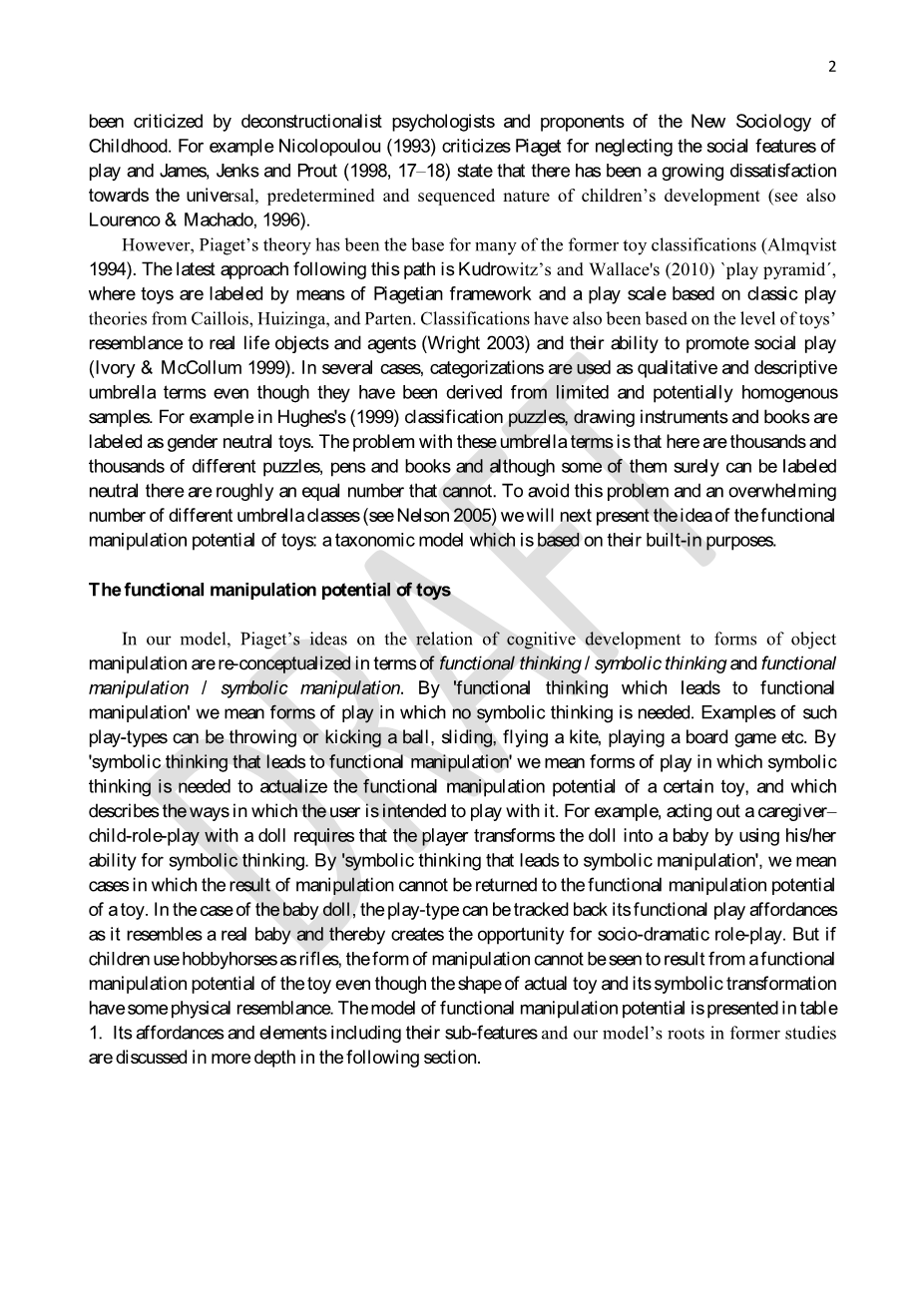

英语原文共 17 页,剩余内容已隐藏,支付完成后下载完整资料
The Value of Toys: 6–8 -year-old childrenrsquo;s toy preferences and the functional analysis of popular toys
Faculty of Education, University of Oulu, Oulu, Finland.
Abstract
The aim of this study was to explore the kinds of toy preferred by 6–8-year-old children, asking: how, and on what basis, do children rationalize their preferences for particular toys? Data was collected by interviewing children in their homes. Children chose 8 toys from a tailored catalog and explained why they wanted those particular items. Toys were analyzed with the aid of a framework designed to test their functional manipulation potential. The childrens reasoning was analyzed by means of inductive content analysis. Two kinds of values were found: 1.) those which reside in the toy itself; and 2.) those which children give to toys. Sub-categories relating to material, social, and personal values were identified from the given values. The present paper deepens knowledge of the value of toys not only as playthings but also as cultural artifacts which children use as one form of their voice.
Keywords: toy, preference, play, affordance
Introduction: a Piagetian approach to playing with toys
This study is a part of broader research project `Play in different contextsacute;, which is being conducted in collaboration with a Finnish toy importer and marketing company.1 In this article, our focus is on the views of 6–8-year-old children concerning the value of toys. The present paper compares the views expressed by a test-group of children regarding the particular features of toys they consider important during the process of toy selection with our own expectations (based on the available research literature) concerning the impact of particular affordances and built-in features of toys in the formation of childrenrsquo;s preferences.
As our focus in this study is on playing with toys, we will approach play as a form of object manipulation. Here we are following a developmentalistic approach which finds its roots in Jean Piaget who identified a strong relation between play and development which could be divided into certain stages. Piaget addresses cognitive development as an internal process and separates out the types of play that occur before and after children learn to combine imagination with action. The earliest forms of play, where no use of imagination occurs, are what Piaget calls lsquo;practice playrsquo;. When the imagination has developed enough, surrounding objects no longer determine the content of play as children are capable of manipulating their meanings through symbolic object transformation (a process which Piaget named lsquo;symbolic playrsquo;). A third stage, according to Piaget is lsquo;rule playrsquo;, in which rules can be either given (as in games), or created spontaneously during play. (Blake amp; Pope, 2008; Matusov amp; Hayes, 2000, 216; Nicolopoulou, 1993; Piaget, 1962, 97–98, 143–146.) However it should be noted that Piagetrsquo;s theory regarding the development of play does not hold a monopolizing position in the field of play-theory, and that the broader idea of developmentalism has
* Corresponding author. Email: pekka-oskari.mertala@oulu.fi
1 This work was supported by the LEIKKAAMO-project under Grant [24301143].
Pekka Mertala*, Hannele Karikoski, Liisa Tauml;htinen amp; Vesa-Matti Sarenius
2
been criticized by deconstructionalist psychologists and proponents of the New Sociology of Childhood. For example Nicolopoulou (1993) criticizes Piaget for neglecting the social features of play and James, Jenks and Prout (1998, 17–18) state that there has been a growing dissatisfaction towards the universal, predetermined and sequenced nature of childrenrsquo;s development (see also Lourenco amp; Machado, 1996).
However, Piagetrsquo;s theory has been the base for many of the former toy classifications (Almqvist 1994). The latest approach following this path is Kudrowitzrsquo;s and Wallaces (2010) `play pyramidacute;, where toys are labeled by means of Piagetian framework and a play scale based on classic play theories from Caillois, Huizinga, and Parten. Classifications have also been based on the level of toysrsquo; resemblance to real life objects and agents (Wright 2003) and their ability to promote social play (Ivory amp; McCollum 1999). In several cases, categorizations are used as qualitative and descriptive umbrella terms even though they have been derived from limited and potentially homogenous samples. For example in Hughess (1999) classification puzzles, drawing instruments and books are labeled as gender neutral toys. The problem with these umbrella terms is that here are thousands and thousands of different puzzles, pens and books and although some of them surely can be labeled neutral there are roughly an equal number that cannot. To avoid this problem and an overwhelming number of different umbrella classes (see Nelson 2005) we will next present the idea of the functional manipulation potential of toys: a taxonomic model which is based on their built-in purposes.
The functional manipulation potential of toys
In our model, Piagetrsquo;s ideas on the relation of cognitive development to forms of object manipulation are re-conceptualized in terms of functional thinking / symbolic thinking and functional manipulation / symbolic manipulation. By functional thinking which leads to functional manipulation we mean forms of play in which no symbolic thinking is needed. Examples of such play-types can be throwing or kicking a ball, sliding, flying a kite, playing a board game etc. By symbolic thinking that leads to functional manipulation we mean forms of play in which symbolic thinking is needed to actualize the functional manipulation potential of a certain toy, and which describes the ways in
剩余内容已隐藏,支付完成后下载完整资料
资料编号:[259753],资料为PDF文档或Word文档,PDF文档可免费转换为Word


